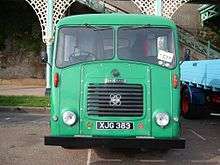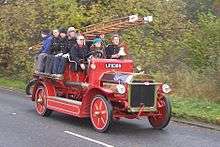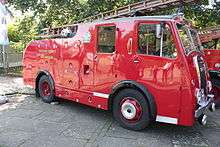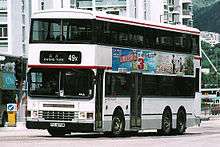Dennis Specialist Vehicles
|
The later style of Dennis badge | |
| Industry | Automotive |
|---|---|
| Fate | Merged with Alexander and Plaxton |
| Successor |
Alexander Dennis Limited (Chassis Group) John Dennis Coachbuilders Dennis Eagle Limited |
| Founded | 1895 |
| Founder | Dennis Brothers |
| Defunct | 2001 |
| Headquarters | Guildford, England |
| Parent |
Hestair Group (1972-1989) Trinity Holdings (1989-1998) Mayflower Corporation (1998-2004) |

Dennis Specialist Vehicles Limited was a major British manufacturer of specialised commercial vehicles based in Guildford, England. The company was best known as the manufacturer of fire engines, although its other major product lines were buses, dustcarts and airport service vehicles.
History
Originally known as Dennis Brothers Ltd, the company was founded in 1895 by brothers John Cawsey (1871–1939) and (Herbert) Raymond (1878–1939) Dennis who made Speed King bicycles[1] which they sold from their shop, the Universal Athletic Stores, in Guildford. They made their first motor vehicle in 1898, and in 1899, their first car; though shown at the National Cycle Show, it was never produced or sold.[2] They entered car production around 1900.[3] About this time John Dennis built the 30,000 square foot three storey building with lift between floors later known as the Rodboro Buildings, the first purpose-built motor vehicle factory in Britain, to manufacture motor vehicles in Onslow Street in the centre of Guildford.[4] Larger models followed with a 35 hp (26 kW; 35 PS) model in 1906 powered by a White and Poppe engine; this power unit was soon fitted to all their models.
Commercial vehicle activity was increasing with the first bus being made in 1903 and fire engine in 1908. Cars soon took second place and it is doubtful if any were made after about 1915.
In 1913 Dennis Brothers moved to a new much larger building of almost four acres on a twelve acre site at Woodbridge on the outskirts of Guildford leaving Onslow Street solely for repairs.[5] The rate of expansion of the business may be gauged from the following expansions at Woodbridge in 1907, 1910, 1912and 1913. In mid-1913 an offer of shares to the public made the business owner a public listed company. At that time the business was described as manufacturers of motor-vans, motor-lorries, motor-fire-engines, motor-cars etc.[6][7]
Wartime production was reduced to military lorries for the War Office and the Dennis turbine fire engine.[8] New buildings were added to contain the manufacture of munitions.[9]
White and Poppe in Coventry has always supplied engines for Dennis Brothers motor vehicles. It had been under consideration from before the war and it was announced in April 1919 that Dennis Brothers and White and Poppe had agreed to an exchange of shares in each other's business.[10] the fact being to give Dennis Brothers a controlling interest in the other company. Mr White and Mr Poppe joined the Dennis Brothers board.[11]and transferred engine production from Coventry to Guildford.
The Karnataka Fire and Emergency Services owns a pumper that was built by Dennis Brothers and delivered to the erstwhile Kingdom of Mysore in 1925 from England.[12]
In 1972 the company was acquired by Hestair Group and renamed Hestair Dennis after a few years of financial difficulties. It was sold to Trinity Holdings (formed from a management buyout from Hestair Group) in 1989 and then to Mayflower Corporation in October 1998.
As of the 1990s, the company was no longer a single integrated whole, but was three independent businesses which their parent company is Dennis Group plc, namely:
- Dennis Fire - manufacturer of fire appliances.
- Dennis Bus - manufacturer of buses and other public transport vehicles
- Dennis Eagle - manufacturer of dustcarts/refuse lorries (municipal vehicles). This company also incorporated the remains of the Eagle Engineering and Shelvoke and Drewry concerns.
Dennis Group plc also owned Duple Metsec, the bus bodywork builder which usually supplied body kits for assembly overseas.
Mayflower Corporation sold Dennis Eagle in July 1999 and purchased by Ros Roca in 2006. Dennis Bus and Dennis Fire were incorporated into Transbus International (now Alexander Dennis) in 2001.
Products
Fire engines


Dennis fire engines were noted, from the outset, for their use of a centrifugal pump or 'turbine' as a water pump, rather than the piston pumps used by other makers. This was more complex to build than the long-established piston pumps, but had advantages in operation. Where water was supplied under pressure from a hydrant, rather than by suction from a pond, this additional pressure was boosted through the centrifugal pump, whereas a piston pump would have throttled it. Piston pumps also gave a pulsating outlet pressure which required an air-filled receiver to even this out.[13]
- N-Type 1905-1920s
- G-Type
- Big Four
- Big Six
- Light Four
- Ace
- F series - 1946-1970s
- Delta
- D series
- DS series - 1980s-1990s
- R series - 1976-?
- RS series - 1978-1990s
- SS series - 1981-1990s
- DF series
- DFS series
- TF series
- TSD series
- Sabre - 1995-2007
- Rapier - 1991-?
- Dagger - ?-2007
Buses




- 1926–1967
- E/EV (front-engined single decker)
- F/FS (bonneted single decker)
- G/GL (bonneted small capacity bus)
- H/HS/HV (front-engined double decker)
- Dart (bonneted small capacity bus)
- Arrow (front-engined single decker)
- Lancet/Lancet 2/Lancet 3/Lancet 4 (front-engined single decker)
- Lance/Lance 2/Lance 3 (front-engined double decker)
- Ace (front-engined small capacity bus)
- Mace (front-engined small capacity bus)
- Falcon (front-engined small capacity bus)
- Pike
- Dominant (underfloor-engined single decker)
- Lancet UF (underfloor-engined single decker)
- Pelican (underfloor-engined light-weight single decker)
- Loline
- 1977–2000
- Dominator
- Jubilant
- Dart - front-engined full-size single-decker bus built in late 1970s
- Falcon
- Lancet
- Dragon/Condor
- Dorchester
- Domino
- Underframe of Duple 425 coach
- Javelin
- Dart/Dart SLF
- Lance/Arrow/Lance SLF
- Trident 2
- Trident 3
- R-Series
Trucks
- Between wars
- Ace
- Max
- Max Major
- Post war
- Pax
- Horia
- Centaur
- Jubilant
- Stork
- Hefty
- Condor
- Heron
- Paravan
- Maxim
- Delta
Refuse trucks
.jpg)
Dennis were noted as specialist makers of refuse collection trucks, with compactors, bin lifters, tipper-body emptying and other specialised features for this market.
Military vehicles (during World War II)
- Loyd Carrier
- Churchill Tank[14]
- Light Artillery Tractor 6 x 6 'Octolat' (a misnomer, standing for 'eight wheel light artillery tractor, retained when the design was abbreviated by one axle to reduce length and weight, and improve handling).
Conceived to meet a requirement for a simple easily produced and maintained alternative to the effective but costly and complicated Quad 4 x 4 tractor, the Dennis design steered on the first pair of wheels but dispensed with springs, substituting six oversized tyres for conventional suspension.
A centre-control driving position in a shallow lightly armoured body provided with ammunition lockers and sheltered under an overall canvas tilt resulted in a vehicle not instantly recognisable as truck. (Prototypes used a box body in place of the simple platform and conventional cab). Early models were powered by twin coupled Bedford engines but the final design was powered by a powerful Leyland 9.8 litre engine. Length was 20 feet (6 metres), height 7ft 6 inches (2.3 metres) high.
Despite promising test results no production order was forthcoming.[15]
Joint ventures
- UMW-Dennis Specialist Vehicles - joint venture with UMW Corporation, based in Malaysia (1995–2002), renamed UMW Vehicle Components after the end of joint venture
- Thomas Dennis Company LLC - joint venture with Thomas Built Buses, based in the United States (1999–2003)
See also
- Alexander Dennis - now "owns" Dennis Bus and Dennis Fire
- John Dennis Coachbuilders
References
- ↑ Wise, David Burgess. "Dennis: Bicycles, Motor Cycles, and Fire Engines", in Ward, Ian, executive editor. World of Automobiles (London: Orbis, 1974), Volume 5, p.527.
- ↑ Wise, p.527.
- ↑ Wise, p.527.
- ↑ History
- ↑ The Times, Friday, Mar 07, 1913; pg. 13; Issue 40153
- ↑ New Capital Issues. The Times, Monday, Mar 10, 1913; pg. 16; Issue 40155
- ↑ Dennis Brothers (1913) Limited. The Times, Monday, Mar 10, 1913; pg. 17; Issue 40155.
- ↑ Dennis Brothers (1913) (Limited). The Times, Tuesday, Nov 23, 1915; pg. 13; Issue 41019.
- ↑ Dennis Brothers (1913) (Limited). The Times, Friday, Nov 24, 1916; pg. 15; Issue 41333.
- ↑ City News in Brief. The Times, Wednesday, Apr 09, 1919; pg. 21; Issue 42070
- ↑ Company Meeting. The Times, Tuesday, Apr 22, 1919; pg. 18; Issue 42080
- ↑ Govindarajulu, Priyanka (13 April 2011). "This Dennis is far from being a menace". The Hindu. Retrieved 28 November 2013.
- ↑ "The Dennis Turbine Fire Engine.". Commercial Motor. 23 July 1908.
- ↑ http://www.bbc.co.uk/iplayer/episode/b01q04ry/Great_British_Railway_Journeys_Series_4_Portsmouth_to_Gomshall/
- ↑ Ellis, Chris; Bishop, Denis (1971). Military Transport of World War II. 167 High Holborn, London WC1V 6PH: Blandford Press. pp. 34, 124. ISBN 0-7137-0702-X.
External links
| Wikimedia Commons has media related to Dennis vehicles. |
- John Dennis Coachbuilders - Fire Engine Manufacturers - Specialist Fire Vehicle Bodybuilder
- Dennis Society
- Aldershot & District Bus Interest Group - Dennis buses in service with their once largest customer
- Dennis Specialist Vehicles records at Surrey History Centre
- photo of 1936 Dennis lorry ANK969 in LMS livery in 1971 and restored, but in plain livery.